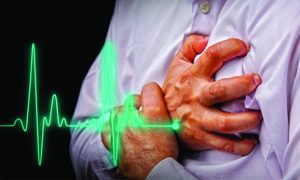Dr. Adrian Danchenko weighs in on what patients need to know
 Lehigh Regional Medical Center’s current administration is exceptionally focused on recruiting and retaining a dedicated group of specialists and subspecialists to further develop their hospital’s depth and breadth of services for the local community. Efforts are currently underway to open a diagnostic cardiac catheterization laboratory. Two months ago, they recruited Dr. Adrian Danchenko for his highly-sought after Invasive Cardiology expertise. Dr. Danchenko has been practicing for over 25 years and specializes in cardiovascular disease. He obtained his medical education through the Uniform Services University of Health Science, Bethesda, MD, the only military medical school in the United States.
Lehigh Regional Medical Center’s current administration is exceptionally focused on recruiting and retaining a dedicated group of specialists and subspecialists to further develop their hospital’s depth and breadth of services for the local community. Efforts are currently underway to open a diagnostic cardiac catheterization laboratory. Two months ago, they recruited Dr. Adrian Danchenko for his highly-sought after Invasive Cardiology expertise. Dr. Danchenko has been practicing for over 25 years and specializes in cardiovascular disease. He obtained his medical education through the Uniform Services University of Health Science, Bethesda, MD, the only military medical school in the United States.
Dr. Danchenko, what made you decide to go into medicine?
My decision to go into medicine could be considered a lifelong pursuit. At the age of seven or eight, with my parent’s guidance, I decided that I wanted to be a physician. I had a keen interest in science and engineering, how things work and how they are put together biologically. Throughout my young life, I focused on the “how and why” realizing that medical school would help me apply this knowledge to help people and have an impact on their lives. When I first went to medical school, I intended to specialize in neurosurgery, but during my medical school education, I decided that cardiology was the best fit for my interests and skills. As a cardiologist, I believe, I can provide the greatest impact on an individual’s longevity and quality of life. At an early age, I was certain that I would pursue a career in medicine, and I never deviated from that plan.
How did serving in the Navy prepare you for your career in cardiology?
Serving in the Navy didn’t necessarily prepare me for medicine or cardiology. I went into the Navy to go to medical school to both serve my country, as well as get my medical education. What’s unique about military medical school is the depth and breadth of the entire educational experience. You are trained in the treatment of trauma, triage, field medicine, and even your internship exposes you to a broad array of specialties to prepare you to potentially serve as a general medical officer (GMO). As a General Medical Officer, you are a classically trained “general practitioner” with a focus on emergency and trauma medicine. I was afforded the opportunity to serve several years as a GMO in the field with the US Marines. Having this experience and exposure provided me with a greater degree of maturity within the medical field, as well as a profound respect for the amount of responsibility that goes with it. It also solidified my decision to focus on the cardiology specialty. In my own experience as a GMO, I saw more than 70% of the physicians completely change their decision regarding specialty training, secondary to this maturing process. This time of service allows you to truly appreciate what is important to you as a physician and where your true passion lies.
What are some common symptoms that patients tend to overlook regarding their heart health that may be significant indicators of cardiovascular disorders?
The most common symptom is not having any symptom at all. Due to the lifestyle choices people have made in this country, many patients will require cardiac care at some point in their life, but most people will not have any of the classic symptoms. The diabetes epidemic is contributing to the number of cardiovascular related issues and disorders that people are facing. With a lack of exercise, obesity, and poor dietary choices, heart disease is looming. Given the longer lifespan that most people are experiencing, especially here in Florida with our aging population, if people remain sedentary and live the “luxury” of not having to do much physical activity, they can be asymptomatic, until late in the disease process. Several reasons account for this. First, diabetes will mask the symptoms of angina and shortness of breath may be the only one present. Second, by not performing any regular physical activity, you are not “testing” you heart. As an analogy, it is just like having that nice shiny recently polished car in the garage. It may look great on the outside, but unless you take it out for a drive, you have no idea if it will even start or drive as expected. By performing some regular exercise, even walking around the block several times every other day, you will be performing a test drive. If you were able to walk the block 3 to 4 times in a half an hour last month, but now have to stop to catch your breath after half a block, you have a problem. Regular exercise, monitoring your sensations and overall comfort level during and after, is the “at home” version of a stress test. Chest discomfort with activity is the other major symptom people have been taught to look for, but many people confuse chest pain with discomfort and don’t consider that tightness, squeezing and pressure are major red flags. The harder it is for a patient to describe their symptoms to me, the more concerned I become. People tend to focus on the intensity and scale of pain, but in cardiology the scale of pain is irrelevant. It’s the nature of the discomfort – squeezing, pulling, tightness, aching, pressure, etc. – with which we are most concerned.
You have advanced training and experience with innovative testing and procedures, what are some critical developments in detecting heart disorders that you utilize in your office?
I am Board Certified in Cardiology and Nuclear Cardiology. Nuclear based imaging modalities are based on the actual perfusion of that heart. This provides a much more sensitive and accurate tool for diagnosing coronary artery disease as compared to a routine stress test that looks only at an EKG. We are also afforded the ability to investigate the heart in individuals who cannot negotiate a treadmill, by performing pharmacologic based imaging. The information obtained from such testing provides much better discriminatory value. To put it simply, it is much better in diagnosing whether you have a problem or not. It will determine whether additional invasive diagnostic testing is warranted. These tests should be done by a trained cardiologist to assure qualified, accurate reporting and proper communication of the results to the referring physician. To have these tests performed by a non-trained physician can be an immense disservice to the patient.
If you could change one thing
about the way people perceive the importance in their heart health, what would it be?
The most effective things that patients can do regarding their heart health are behavioral and lifestyle changes. There are multiple risk factors for coronary artery disease. Three of them are uncontrollable: gender, age and family history. The rest are controllable: diabetes, smoking, hyperlipidemia (high cholesterol), hypertension (high blood pressure) and obesity. If you have a family history of cardiac disease, then the controllable risk factors should be of a much greater concern to you. Patients need to stop smoking. By maintaining an ideal body weight, losing weight if necessary, exercising regularly, and avoiding sugar and simple carbohydrates, you can hopefully avoid diabetes and coronary artery disease. As I tell most of my diabetic patients, it is not whether you will develop coronary artery disease; it is a matter of when. Better to avoid diabetes in the first place.
If you or someone you know needs to have a cardiology consultation, are concerned about your risk factors, or are experiencing symptoms of chest discomfort, shortness of breath or other related issues, please contact Dr. Danchenko’s office today at (239) 369-6115.









